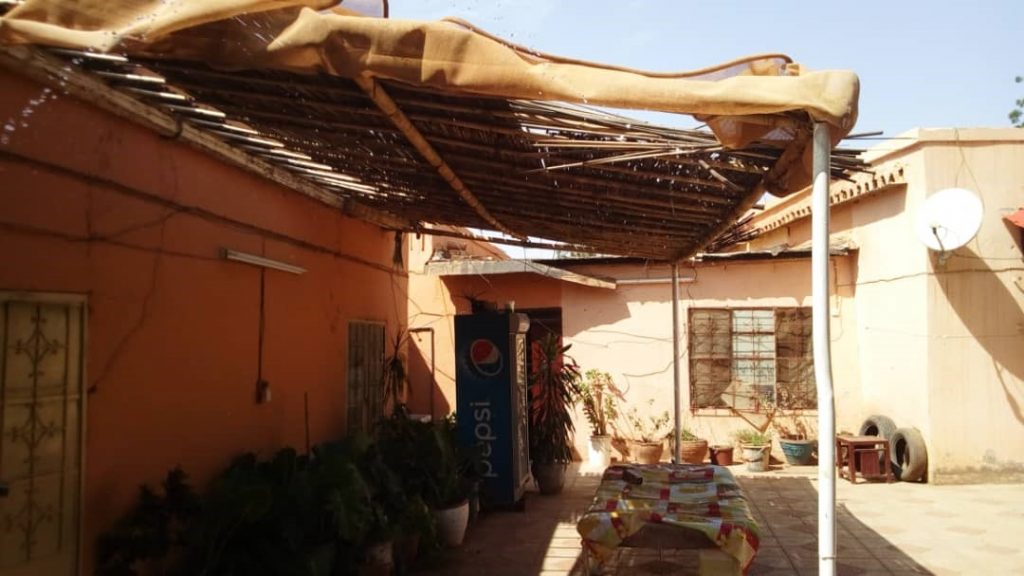By Huda Elsherif, GCDC PhD student in the Kent School of Architecture and Planning
Stepping out of the plane, I was greeted by the strong African sun. A vivid reminder of why I was there. The goal of my fieldwork was to track how Khartoum residents – those in both traditional and modern houses – used their spaces and how having an air-conditioner changed their lifestyles.
Sudan’s power grid cannot cope with energy-hungry air-conditioners, and that’s why power cuts are a daily occurrence in the summer. I lived with two families for three months and got firsthand experience of this reality. That agonizing moment when the lights go off and the fan squeaks to a stop, signaling it is time to go outside. At night, residents are faced with the choice of soldiering through the heat inside or getting eaten alive by mosquitos outside. Life pauses for everyone as they wait hours for the electricity to come back. People have become so reliant on air-conditioners and fans that they simply cannot function without them nowadays. However, it wasn’t like this in the past, as people lived perfectly fine without electricity up until the 1990s. During power cuts, I would chat the hours away with the residents, and they fondly told me about their youth and how their days were mostly spent outside under the shade of a tree or veranda. They recalled how they would chat with family members and neighbours as they went about their chores, drinking tea and coffee throughout. Life was simpler then, and people enjoyed a more relaxed pace.

Interviewing the residents, I noticed a stark difference between the older and younger generations. The older generation grew up with a communal lifestyle where everything was shared – privacy and individuality were taboo. Even families that had an air-conditioner usually had it in just one room where everyone shared it. In those days, individuals did not even have a bed to their name – they slept in whichever bed they found empty that night. But now ‘selfish’ young generations want their ‘own room’, their ‘own phone’ and all the comforts of a modern life. ‘They don’t want to put in the labor it takes to maintain an outdoor yard’. Sudanese yards can be up to 300 square meters and need to be swept and sprayed twice per day if residents want to spend time outside. It is hard work, but past generations had more time. There were so many people in the house to share the workload, as multifamily households were the norm. A desire for privacy and the requirements of a modern lifestyle have created a new family dynamic – the working couple live in a nuclear family setting. Women come home from a 9-5 job and barely have time to finish their chores, let alone socialise as frequently as before. One of the residents said that socialising used to be the highlight of evenings outdoors, but now with fewer people in the house, it’s just not worth the effort.


To better understand the situation, I held interviews with architects and civil servants in the planning ministry. They told me that Sudan has faced large social change in the past few years, and apartments are becoming the new trend. The problem is the poor education and lack of awareness of the designers, which leads to modern buildings that are unbearably hot. During my MSc, I monitored an apartment and was shocked to find that the bedroom would reach 50oC within three hours of turning the air-conditioner off. The resident said that because she didn’t have access to a yard, she had to stay in the car with the air conditioner on for hours. Her toddler simply could not cope with the heat and cried constantly. Although there was an effort to create a sustainable building code, the architect responsible said that the main obstacle he faced was awareness. He told me how he once forced a developer to build classrooms with large windows for ventilation. However, the developer later built additional classrooms with smaller windows because they were cheaper. However, the new classrooms were so hot that the developer had to install large air-conditioners that cost him more in the long run than the larger windows would have from the start. The Sudanese architect said that people simply could not comprehend that spending more upfront saved them money down the road.
I came to Sudan with the goal of investigating how the air-conditioner changed people’s lifestyles, but I found that there was more to the story. The truth is that it is social change that has led people to stay indoors more, and the air-conditioner just made that transition possible. Of course, improved economic conditions are another important driver. Since coming back from Sudan, I have been conducting an archival investigation into how people lived in Sudan in the past 100 years to better understand how this has changed. This has given me eye-opening insights into my own heritage. My goal now? I want to understand how buildings can change to sustainably meet the evolving needs of modern African men and women. Climate change is right around the corner. Which poses the question: if the power grid cannot handle it as it is, what will happen when it becomes even hotter? The time for change is now.

Huda Elsherif is a PhD student in the Kent School of Architecture and Planning and is supervised by Dr Henrik Schoenefeldt. After working for three years at an international engineering consultancy in Sudan, she became a LEED AP and decided to specialize in sustainability, passing her MSc with a distinction in 2019. Her MSc research identified that the thermal comfort issues in Khartoum (Sudan’s capital) along with the increased supply have led to increased air conditioner (AC) consumption and subsequently electricity shortages. Her PhD is an in-depth analysis of the socioeconomic and climatic drivers of the increased AC consumption in Khartoum, she aims to set a framework for sustainable solutions.

